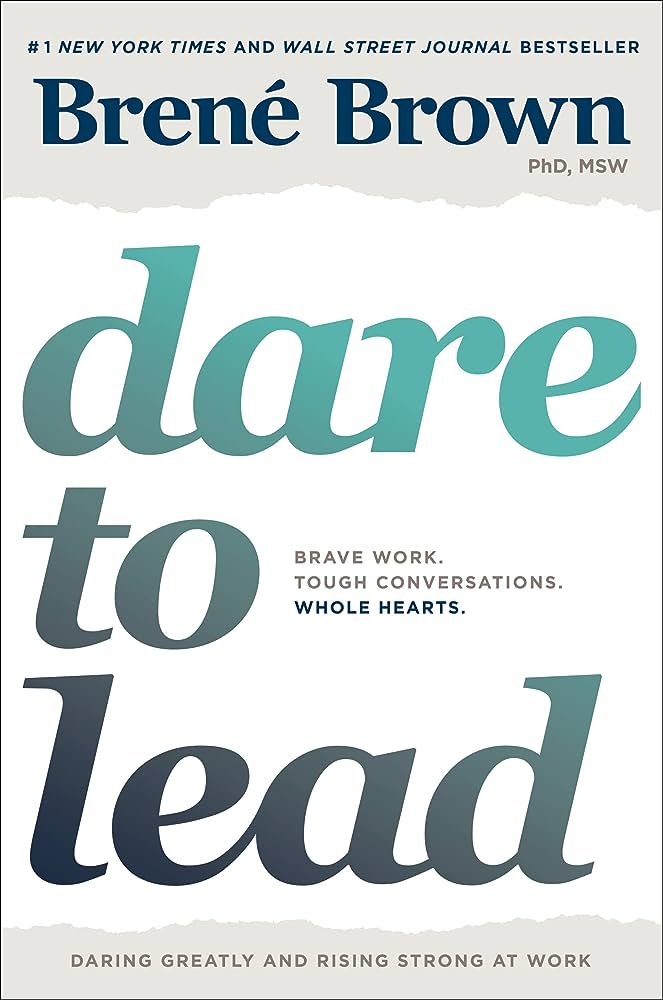
1 Line Summary
What does it take to become a daring leader and build a culture of courage within an organisation? This is the main question that Brené Brown addresses in her book Dare To Lead.
What Will You Learn
The book teaches practical tips and tools to become an elegant leader. You’ll learn how to:
- Embrace vulnerability,
- Build trust,
- Live with your values,
- Bounce back from failures and cope obstacles,
- Become a daring leader.
Best Quotations from the Book
- “Courage is a collection of four skill sets that are teachable, measurable, and observable. The four skill sets that make up courage are: Rumbling with Vulnerability, Living into Our Values, Braving Trust, and Learning to Rise.”
- “A rumble is a discussion, conversation, or meeting defined by a commitment to lean into vulnerability, to stay curious and generous, to stick with the messy middle of problem identification and solving, to take a break and circle back when necessary and to be fearless in owning our parts.”
- “A sense of belonging is not something that we negotiate with external forces—it’s something we carry in our heart. It’s finding the sacredness in being a part of something and in braving the wilderness alone when we’re called to stand alone. It’s also honoring our shared humanity and our differences.”
- “Trust is earned in the smallest of moments. It is earned not through heroic deeds, or even highly visible actions, but through paying attention, listening, and gestures of genuine care and connection.”
- “The irony is that we attempt to disown our difficult stories to appear more whole or more acceptable, but our wholeness—even our wholeheartedness—actually depends on the integration of all of our experiences, including the falls.”
- “We can’t be all things to all people. We can’t do all things at once. We can’t do all things equally well. We can’t do all things better than everyone else. Our humanity is made up of strengths and limitations. Our success is defined by how we leverage our strengths and account for our limitations.”
- “The most transformative and resilient have three things in common: First, they recognize the central role that relationships and story play in culture and strategy, and they stay curious and connected. Second, they understand and stay curious about how emotion and vulnerability affect behavior and decision making. And, third, they have the ability and willingness to lean in to discomfort and vulnerability.”
- “The root of the word courage is cor—the Latin word for heart. In one of its earliest forms, the word courage had a very different definition than it does today. Courage originally meant “To speak one’s mind by telling all one’s heart.” Over time, this definition has changed, and today, courage is more synonymous with being heroic”
- “ Heroics are important and we certainly need heroes, but I think we’ve lost touch with the idea that speaking honestly and openly about who we are, about what we’re feeling, and about our experiences (good and bad) is the definition of courage.”
- “Values are the beliefs that guide our actions, give us direction, and help us stay true to ourselves. When we don’t know our values or when we compromise them for other people or for the wrong reasons, we lose our way. We lose our authenticity and our integrity, and we end up feeling like we’re being pushed around by the world rather than charting our own course.”
- “Owning our stories means acknowledging our feelings and wrestling with the hard emotions—our fear, anger, aggression, shame, and blame. This isn’t easy, but the alternative—denying our stories and disengaging from emotion—means choosing to live our lives in the dark.”
Book Summary
What is a leader? According to Brené Brown, a leader is:
“Anyone who takes responsibility for finding the potential in people and processes, and who has the courage to develop that potential.”
Courage is a collection of 4 skill sets that can be taught, observed, and measured:
- Rumbling with vulnerability
- Living into our values
- Braving trust
- Learning to rise
1. Rumbling with Vulnerability
- Rumbling with vulnerability is having the courage to show up, be seen, and stay in tough conversations when we can’t control the outcome.
- Vulnerability is not a weakness but an emotion we feel during the times of risk, uncertainty and emotional exposure.
- Vulnerability is the origin of many of the behaviors,like creativity, accountability and difficult conversations that define daring leadership.
- To rumble with vulnerability, we need to challenge the myths that keep us afraid, e.g. believing that we can opt out of vulnerability or that we can go it alone.
- We also need to develop the skills and practices that support us in staying vulnerable like curiosity, empathy, self-compassion and grounded confidence.
- Grounded confidence is not the same as being confident. It is the belief that we can rumble with vulnerability and own our story, rather than letting fear write it for us.
- One of the tools for rumbling with vulnerability is “the story I’m telling myself”, which helps in sharing our emotions, assumptions, and fears in a non-blaming way.
SFD (Shitty First Draft)
- SFD is a technique to capture our initial thoughts and feelings about a situation before we edit, rationalize, or make up stories. It’s about acknowledging our raw, unfiltered reactions.
- The SFD serves as a self-awareness tool, helping us to recognize our emotions, assumptions, and fears. It’s a way to own our emotions and get curious about them.
- The SFD is a starting point for the “rumble” – a process of inquiry and conversation where we challenge our own narratives and seek deeper understanding.
Rumbling with vulnerability also requires us to recognize and address the common types of armor, like perfectionism, cynicism, numbing and hustling for approval, to protect ourselves from feeling vulnerable.
As a whole, it is a lifelong practice that we can apply to any situation where we want to show up as daring leaders. It is not easy or comfortable but essential for courage and connection.
2. Living into Our Values
- Values are standard behaviors that we hold most important in life. They guide our actions and decisions.
- Living into our values means practicing them as a standard of life. We need to align our intentions, words, thoughts and behaviors with our values.
- The first step of living into values is to name them. We need to identify the two core values that we hold most important which can define who we are.
- The second step is operationalizing them. We need to translate our values into specific behaviors that we can observe, measure, and teach.
- The third step is integrating values into culture. We need to create a clear culture which reflects our values and holds us accountable for living them.
- Living into our values requires courage and vulnerability. We need to be brave enough to express our values, even when they are in conflict with others or the status quo.
- It also requires empathy and connection. We need to listen to and understand others’ values, even when they are different from ours or challenge us.
- Living into values helps us stay grounded and resilient. We need to revisit our values regularly, check our alignment, and make adjustments when necessary.
3. Braving Trust
- Trust is a key factor for successful leadership and teamwork, but it is often hard to define and measure.
- Trust is built through small actions and behaviors that show respect, reliability, accountability, integrity, and empathy.
BRAVING Inventory
The BRAVING Inventory can be used to assess and improve trust with others and with one’s own self. The seven elements of BRAVING inventory are:
- Boundaries: Setting and communicating clear personal boundaries about right and wrong.
- Reliability: Being aware of competencies and limitations, and the ability to deliver outputs as per expectations.
- Accountability: Owning mistakes, apologizing and making necessary amendments.
- Vault: Respecting and valuing confidence, maintaining due trust as per expectations and values.
- Integrity: Choosing to practice values rather than simple prophesy.
- Non-judgment: Being open to ask for help and allowing others to do the same, without judgment.
- Generosity: Extending most generous interpretation of other’s intentions, words and actions.
- Trust is not a one-way street, but a reciprocal relationship that involves both giving and receiving trust. One needs to be trustworthy and trusting to build trust.
- Trust is a must-have for effective leadership and organizational performance. It can increase engagement, innovation, collaboration, and results.
- Trust is not a soft skill, but a courageous and vulnerable practice that challenges us to show up authentically and wholeheartedly. Trust is the foundation of daring leadership.
4. Learning to Rise
- Learning to rise is the process of bouncing back from setbacks and failures. Failure is not the opposite of success but a part of the journey.
- Reckoning: To rise from a challenge or disappointment, first acknowledge and name your emotions. Use a feelings wheel or journal to identify and express your feelings.
- Rumble: Question the stories you tell yourself about what happened. Challenge assumptions and beliefs that may not be true. Use the SFD technique to write initial thoughts and ask questions to test their validity.
- Revolution: Based on insights and learnings from the Rumble stage, transform your stories and actions. Move forward in a more positive and self-empowering way.
- Physics of Vulnerability: Vulnerability is a dynamic state that changes depending on the situation and the people involved. It’s contagious and encourages others to be more open and courageous.
- Shame and empathy are two emotions that play a crucial role in learning to rise. Brown defines shame as the feeling that we are unworthy of love and belonging and empathy as the ability to understand and share the feelings of another. Shame can hinder our resilience and empathy can help us overcome it.
Unleash your inner courage and become a daring leader who inspires and empowers others, based on Brené Brown’s groundbreaking research on vulnerability and courage.
Read “The 5 Levels of Leadership: Proven Steps to Maximize Your Potential”, “The Coaching Habit “, “Extreme Ownership” and “14 Essential Leadership Qualities“


Pingback: “Five Dysfunctions of a Team” by P. Lencioni: Book Summary
Pingback: “The One Minute Manager” by K.Blanchard and S.Johnson: Book Summary
Pingback: “How to Lead Smart People” : Book Summary »
Pingback: "The Leadership Challenge" by Kouzes & Posner: Book Summary